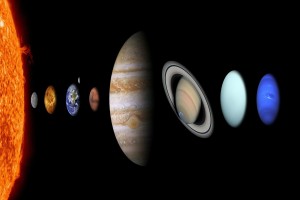
X‐ray emissions have been detected from comets, Venus, Earth, Mars, Saturn, Pluto, Jupiter, and several of Jupiter’s moons. For Mercury, which is too close to the Sun to be observed by the Earth‐orbiting X‐ray observatories, in‐situ X‐ray instruments have provided detailed maps of the planet’s X‐ray emissions. Auroral emissions are known to brighten when interplanetary shocks in the solar wind collide with the magnetospheres of the bodies. For the neutral and dusty coma of comets, charge exchange from the collision of solar wind ions is also believed to be a key contributor of X‐ray emission.
X‐ray aurorae have been observed from the poles of Earth and Jupiter. On Earth, we can see colourful light shows in the sky called auroras, which happen when high-energy particles interact with the atmosphere. X-rays are emitted in Earth’s auroras, produced by energetic electrons after they travel down the planet’s magnetic field lines to its poles and are slowed down by the atmosphere.
Jupiter has auroras, too. Jupiter’s X‐ray aurora is thought to be predominately produced by the precipitation of particles from the volcanoes on its moon Io. However, there are also some less frequent observations that show indications of solar wind particles charge exchanging with the atmosphere. The X-rays from auroras on Jupiter hence, come from two sources: electrons traveling down magnetic field lines, as on Earth, and positively charged atoms and molecules raining down at Jupiter’s polar regions.
For the hydrogen‐dominated atmospheres of Jupiter and Saturn, equatorial X‐ray emission is predominately due to elastic‐scattering of solar photons and therefore varies with the solar X‐ray intensity. For Venus and Mars, the higher relative abundances of larger molecules in the atmosphere result in higher contributions by X‐ray fluorescence emissions, for example, lines from the CO2 rich atmosphere.
In nutshell, within the solar system, X‐ray emissions had been detected from every planet except the Ice Giants: Uranus and Neptune.
Now astronomers have detected X-rays from Uranus for the first time, using NASA’s Chandra X-ray Observatory. This result may help scientists learn more about this enigmatic ice giant planet in our solar system. However, scientists are less certain about what causes auroras on Uranus. Chandra’s observations may help figure out this mystery. (NASA’s Marshall Space Flight Center manages the Chandra program. The Smithsonian Astrophysical Observatory’s Chandra X-ray Center controls science from Cambridge Massachusetts and flight operations from Burlington, Massachusetts).
The study of X‐ray emissions from planets provide key and often unique insights into a variety of characteristics of the system. Most relevant for Uranus, these include: atmospheric, surface and planetary ring composition through fluorescence or scattering; magnetosphere‐ionosphere coupling through auroral studies; and the nature of solar wind interactions through charge exchange emissions. One of the many factors that makes Uranus an interesting target is the configuration of its magnetosphere.
Determining the sources of the X-rays from Uranus could help astronomers better understand how more exotic objects in space, such as growing black holes and neutron stars, emit X-rays.
The relative abundance of Carbon-Nitorgen-Oxygen (CNO) elements is higher in Uranus than Saturn, which may lead it to be an intermediate between the elastic scattering dominated atmospheres of Jupiter and Saturn and the fluorescence dominated atmospheres of Venus and Mars.
Uranus is an especially interesting target for X-ray observations because of the unusual orientations of its spin axis and its magnetic field. The planet, which has four times the diameter of Earth, rotates on its side, making it different from all other planets in the solar system. While the rotation and magnetic field axes of the other planets of the solar system are almost perpendicular to the plane of their orbit, the rotation axis of Uranus is nearly parallel to its path around the Sun. Furthermore, while Uranus is tilted on its side, its magnetic field is tilted by a different amount, and offset from the planet’s center. This may cause its auroras to be unusually complex and variable.
In the new study, researchers used Chandra observations taken in Uranus in 2002 and then again in 2017. They saw a clear detection of X-rays from the first observation, just analysed recently, and a possible flare of X-rays in those obtained fifteen years later.

The main graphic shows a Chandra X-ray image of Uranus from 2002 (in pink) superimposed on an optical image from the Keck-I Telescope obtained in a separate study in 2004. The latter shows the planet at approximately the same orientation as it was during the 2002 Chandra observations.
What could cause Uranus to emit X-rays? The answer: mainly the Sun. Astronomers have observed that both Jupiter and Saturn scatter X-ray light given off by the Sun, similar to how Earth’s atmosphere scatters the Sun’s light. While the authors of the new Uranus study initially expected that most of the X-rays detected would also be from scattering, there are tantalizing hints that at least one other source of X-rays is present. If further observations confirm this, it could have intriguing implications for understanding Uranus.
One possibility is that the rings of Uranus are producing X-rays themselves, which is the case for Saturn’s rings. Uranus is surrounded by charged particles such as electrons and protons in its nearby space environment. If these energetic particles collide with the rings, they could cause the rings to glow in X-rays. Another possibility is that at least some of the X-rays come from auroras on Uranus, a phenomenon that has previously been observed on this planet at other wavelengths.
A paper titled ‘A Low Signal Detection of X‐Rays From Uranus’, describing these results appears in the most recent issue of the Journal of Geophysical Research and is available online. The authors are William Dunn (University College London, United Kingdom), Jan-Uwe Ness (University of Marseille, France), Laurent Lamy (Paris Observatory, France), Grant Tremblay (Center for Astrophysics | Harvard & Smithsonian), Graziella Branduardi-Raymont (University College London), Bradford Snios (CfA), Ralph Kraft (CfA), Z. Yao (Chinese Academy of Sciences, Beijing), Affelia Wibisono (University College London).
– global bihari bureau





